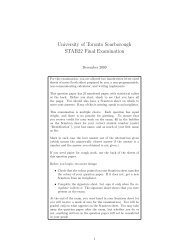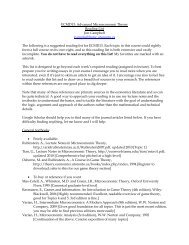Download PDF - University of Toronto Scarborough
Download PDF - University of Toronto Scarborough
Download PDF - University of Toronto Scarborough
You also want an ePaper? Increase the reach of your titles
YUMPU automatically turns print PDFs into web optimized ePapers that Google loves.
161..174<br />
Biological Journal <strong>of</strong> the Linnean Society, 2011, 102, 161–174. With 5 figures<br />
Molecular systematics <strong>of</strong> flyingfishes (Teleostei:<br />
Exocoetidae): evolution in the epipelagic zone<br />
ERIC A. LEWALLEN 1 *, ROBERT L. PITMAN 2 , SHAWNA L. KJARTANSON 1,3 and<br />
NATHAN R. LOVEJOY 1<br />
1<br />
Department <strong>of</strong> Biological Sciences, <strong>University</strong> <strong>of</strong> <strong>Toronto</strong> <strong>Scarborough</strong>, 1265 Military Trail, <strong>Toronto</strong>,<br />
Ontario, M1C 1A4, Canada<br />
2<br />
Protected Resources Division, Southwest Fisheries Science Center, National Marine Fisheries Service,<br />
National Oceanic and Atmospheric Administration, 8604 La Jolla Shores Drive, La Jolla, CA 92037,<br />
USA<br />
3<br />
AECOM Canada Ltd., 99 Commerce Drive, Winnipeg, Manitoba, R3P 0Y4, Canada<br />
Received 7 April 2010; revised 18 July 2010; accepted for publication 18 July 2010bij_1550<br />
The flyingfish family Exocoetidae is a diverse group <strong>of</strong> marine fishes that are widespread and abundant in tropical<br />
and subtropical seas. Flyingfishes are epipelagic specialists that are easily distinguished by their enlarged fins,<br />
which are used for gliding leaps over the surface <strong>of</strong> the water. Although phylogenetic hypotheses have been<br />
proposed for flyingfish genera based on morphology, no comprehensive molecular studies have been performed. In<br />
the present study, we describe a species-level molecular phylogeny for the family Exocoetidae, based on data from<br />
the mitochondrial cytochrome b gene (1137 bp) and the nuclear RAG2 gene (882 bp). We find strong support for<br />
previous morphology-based phylogenetic hypotheses, as well as the monophyly <strong>of</strong> most currently accepted flyingfish<br />
genera. However, the most diverse genus Cheilopogon is not monophyletic. Using our novel flyingfish topology, we<br />
examine previously proposed hypotheses for the origin and evolution <strong>of</strong> gliding. The results support the progressive<br />
transition from two-wing to four-wing gliding. We also use phylogenetic approaches to test the macroecological<br />
effects <strong>of</strong> two life history characters (e.g. egg buoyancy and habitat) on species range size in flyingfishes. © 2010<br />
The Linnean Society <strong>of</strong> London, Biological Journal <strong>of</strong> the Linnean Society, 2011, 102, 161–174.<br />
ADDITIONAL KEYWORDS: Beloniformes – cytb – gliding strategies – mtDNA – nuclear DNA – phylogeny<br />
– RAG2.<br />
INTRODUCTION<br />
The marine epipelagic zone is one <strong>of</strong> the largest and<br />
most productive habitats on Earth, although it exhibits<br />
remarkably low species diversity (Angel, 1993).<br />
Survival in epipelagic habitats presents a number <strong>of</strong><br />
specific challenges for fishes, including the rarity<br />
<strong>of</strong> substrate for egg deposition and refuges, and a<br />
highly patchy distribution <strong>of</strong> resources (Parin, 1968;<br />
Hamner, 1995; Allen & Cross, 2006). Epipelagic fishes<br />
are also exposed to predators and powerful abiotic<br />
forces (e.g. ocean currents) during all phases <strong>of</strong> their<br />
lifecycles. As a result, epipelagic species exhibit an<br />
*Corresponding author. E-mail: eric.lewallen@utoronto.ca<br />
array <strong>of</strong> specialized adaptations. Reproductive characteristics<br />
that compensate for the absence <strong>of</strong> benthic<br />
substrate (e.g. buoyant eggs or egg filaments for<br />
attachment to floating debris and vegetation) and<br />
adaptations for predator avoidance (e.g. defensive<br />
spines, cryptic coloration, and protective schooling<br />
behaviour) are present in many epipelagic taxa<br />
(Hamner, 1995; Nelson, 2006). Among the most<br />
spectacular adaptations to epipelagic habitats is the<br />
aerial behaviour <strong>of</strong> flyingfishes (and certain species <strong>of</strong><br />
squids), which make gliding leaps from the water,<br />
presumably to evade predators (Mohr, 1954; Evans &<br />
Sharma, 1963; Fish, 1990; Gillett & Ianelli, 1991;<br />
Davenport, 1992; Davenport, 1994; Kutschera, 2005).<br />
The flyingfish family Exocoetidae includes approximately<br />
50 species that are distributed across<br />
the tropical and subtropical regions <strong>of</strong> the Pacific,<br />
© 2010 The Linnean Society <strong>of</strong> London, Biological Journal <strong>of</strong> the Linnean Society, 2011, 102, 161–174 161
162 E. A. LEWALLEN ET AL.<br />
Atlantic, and Indian oceans. A key element <strong>of</strong> epipelagic<br />
food webs, flyingfishes feed on zooplankton and<br />
transfer energy from lower levels <strong>of</strong> the trophic<br />
system to top predators (Parin, 1968). As the predominant<br />
form <strong>of</strong> middle-sized nekton (i.e. actively swimming<br />
organisms < 1 m in length) in the open ocean,<br />
flyingfishes are a critical source <strong>of</strong> food for pelagic<br />
predators such as dolphinfishes, tunas, billfishes,<br />
cetaceans, and pelagic seabirds (Parin, 1968). The<br />
most distinct feature <strong>of</strong> flyingfishes is their greatly<br />
enlarged paired fins, which allow glides above the<br />
surface <strong>of</strong> the water (Davenport, 1994). Some species<br />
have greatly enlarged pectoral fins (two-wing gliders;<br />
also described as monoplane gliders by Breder, 1930),<br />
whereas others have greatly enlarged pectoral and<br />
pelvic fins (four-wing gliders; also described as<br />
biplane gliders by Breder, 1930). Four-wing flyingfishes<br />
can glide up to 400 m, and can accomplish<br />
turns and altitude changes, whereas two-wing gliders<br />
travel shorter distances, usually in a straight line<br />
(Davenport, 1994).<br />
Flyingfishes show variation in life history and<br />
reproductive biology. Although all species are oviparous,<br />
some have specialized egg structures that<br />
allow attachment <strong>of</strong> eggs to floating debris and<br />
seaweed, whereas others lay buoyant eggs on the<br />
surface <strong>of</strong> the open ocean (Collette et al., 1984).<br />
However, some species return to, or continuously<br />
occupy, coastal habitats to complete their life cycle,<br />
whereas others spend their entire lives far <strong>of</strong>fshore in<br />
pelagic habitats. Geographical range size varies considerably<br />
among species, from locally restricted to<br />
circumtropical. For example, Fodiator rostratus is<br />
endemic to the nearshore waters <strong>of</strong> the eastern tropical<br />
Pacific (Parin, 1995), whereas Exocoetus volitans<br />
has a largely pantropical distribution (Parin &<br />
Shakhovskoy, 2000). Life-history traits, such as dispersal<br />
ability <strong>of</strong> eggs and larvae, have been demonstrated<br />
to affect geographic ranges <strong>of</strong> other marine<br />
taxa, including invertebrates and fishes (Bowen &<br />
Avise, 1990; Palumbi, 1992; Knowlton, 1993; Burton,<br />
1998; Palumbi, 2004; Lester et al., 2007; Galarza<br />
et al., 2008; Eble, Toonen & Bowen, 2009; for a review,<br />
see Cowen & Sponaugle 2009). However, correlations<br />
between life history characters and species range size<br />
have not been investigated in flyingfishes.<br />
The Exocoetidae has been proposed as a monophyletic<br />
group within the order Beloniformes based<br />
on both morphological (Bruun, 1935; Parin, 1961;<br />
Collette et al., 1984; Dasilao & Sasaki, 1998) and<br />
molecular studies (Lovejoy, 2000; Lovejoy, Iranpour &<br />
Collette, 2004). However, phylogenetic hypotheses<br />
within the family Exocoetidae have been entirely<br />
based on morphological characters and have focused<br />
on genus-level relationships. Parin (1961; see also<br />
Bruun, 1935) proposed an evolutionary scheme<br />
that grouped seven genera into four subfamilies:<br />
Fodiatorinae, Parexocoetinae, Exocoetinae, Cypselurinae<br />
(with the latter containing the genera Prognichthys,<br />
Cypselurus, Cheilopogon, and Hirundichthys)<br />
(Fig. 1A). Collette et al. (1984) produced a subfamilylevel<br />
analysis, based on morphological characters,<br />
that matched Parin (1961) (Fig. 1A). More recently,<br />
Dasilao & Sasaki (1998; see also Dasilao, Sasaki &<br />
Okamura, 1997) produced a cladistic analysis based<br />
on 41 morphological characters (Fig. 1B), which provided<br />
further support for the trees proposed by Parin<br />
(1961) and Collette et al. (1984). The morphologybased<br />
trees suggest a stepwise evolution <strong>of</strong> gliding<br />
capability, progressing from two-wing gliding (Fodiator,<br />
Parexocoetus, and Exocoetus), to four-wing gliding<br />
(Cypselurinae). These authors also proposed that<br />
Oxyporhamphus, a taxon that shares features with<br />
both flyingfishes and halfbeaks, should be considered<br />
a basal member <strong>of</strong> Exocoetidae (Dasilao et al., 1997).<br />
Lovejoy et al. (2004) presented a molecular phylogenetic<br />
analysis for beloniform fishes that included<br />
eight flyingfish species in seven genera. This analysis<br />
closely agreed with the flyingfish relationships based<br />
on morphological studies, although Parexocoetus and<br />
Fodiator were grouped as sister taxa.<br />
Flyingfishes are an excellent group for studying<br />
the evolution <strong>of</strong> epipelagic adaptations, biogeography,<br />
and marine diversification. However, a species-level<br />
phylogeny is a prerequisite for such investigations. In<br />
the present study, we describe the first molecular<br />
A<br />
B<br />
Cypselurinae<br />
Exocoetinae<br />
Parexocoetinae<br />
Fodiatorinae<br />
Hirundichthys<br />
Prognichthys<br />
Cypselurus<br />
Exocoetus<br />
Parexocoetus<br />
Fodiator<br />
Oxyporhamphus<br />
Figure 1. Phylogenetic hypotheses proposed for flyingfishes<br />
based on morphological characters. A, subfamily<br />
level tree proposed by Parin (1961), Collette et al. (1984).<br />
B, genus level tree proposed by Dasilao & Sasaki (1998).<br />
© 2010 The Linnean Society <strong>of</strong> London, Biological Journal <strong>of</strong> the Linnean Society, 2011, 102, 161–174
MOLECULAR SYSTEMATICS OF FLYINGFISHES 163<br />
phylogeny for the Exocoetidae based on mitochondrial<br />
and nuclear genes. Our objectives were: (1) to generate<br />
a species-level molecular phylogeny for flyingfishes<br />
and compare this with previous morphologybased<br />
hypotheses; (2) to test the monophyly <strong>of</strong><br />
currently accepted flyingfish subfamilies and genera;<br />
(3) to reconstruct the evolution <strong>of</strong> flyingfish gliding<br />
strategies; and (4) to test whether species range size<br />
is correlated with variation in egg buoyancy and<br />
habitat preference.<br />
120 s; followed by a final extension at 72 °C<br />
for 7 min. Sequencing was completed using internal<br />
sequencing primers ExoFwd1 (5′-GCYACCCT<br />
CACCCGATTYTTTAC-3′) and ExoRev1 (5′-CTT<br />
TRTATGAGAAGTAGGGGTGG-3′) (cytb), and F16-<br />
Ch (5′-CTATTTGACCTGGAGTTTGG-3′) and R17-<br />
Ch (5′-GAGTCAGAGGTCAGTGAGTG-3′) (RAG2).<br />
Sequences were examined, edited, and aligned using<br />
Sequencher, version 4.6 (Gene Codes Corporation).<br />
MATERIAL AND METHODS<br />
TAXON SAMPLING<br />
Specimens were collected in the field or donated by<br />
collaborators, with tissues stored in 95% ethanol.<br />
Voucher specimens have been deposited in museum<br />
collections (Table 1). In total, 65 flyingfish individuals<br />
(representing 31 species and seven genera) and ten<br />
outgroup individuals (representing five species and<br />
four genera) were included.<br />
MOLECULAR DATA COLLECTION<br />
Genomic DNA was extracted using DNeasy<br />
kits (Qiagen). The mitochondrial cytochrome b<br />
(cytb) gene (1137 bp) was amplified by polymerase<br />
chain reaction (PCR) and primers ExoCBFwd<br />
(5′-GGACTTATGAYTTGAAAAACCATCGTTG-3′) and<br />
ExoCBRev (5′-AACCTTCGACGTTCGGCTTACAAG<br />
GCCG-3′), which were designed using published<br />
data from actinopterygian (Sevilla et al., 2007) and<br />
beloniform fishes (Lovejoy, 2000). A portion <strong>of</strong> the<br />
recombination activating gene 2 (RAG2) (882 bp)<br />
was amplified using primers Ffly-Ch (5′-ACTGAGA<br />
TGAAGTTGAGACCCAT-3′) and Rfly-Ch (5′-CCTCA<br />
GACTGGAAGCTCACCTG-3′), which were designed<br />
using published data from Beloniformes (Lovejoy &<br />
Collette, 2001; Lovejoy et al., 2004).<br />
PCR for cytb amplifications were performed with<br />
8 mg/L <strong>of</strong> bovine serum albumin, 1 ¥ Taq Polymerase<br />
Buffer, 0.2 mM <strong>of</strong> each dNTP, 2.8 mM MgCl 2, 7.5 mol<br />
<strong>of</strong> each primer, 1.25 U <strong>of</strong> Taq DNA Polymerase (Fermentas<br />
Inc.) and approximately 125 ng <strong>of</strong> genomic<br />
DNA. RAG2 amplifications were performed with<br />
8 mg/L <strong>of</strong> bovine serum albumin, 1 ¥ Taq Polymerase<br />
Buffer, 0.2 mM <strong>of</strong> each dNTP, 2.0 mM MgCl 2,5mol<strong>of</strong><br />
each primer, 1 U <strong>of</strong> Taq DNA Polymerase, and<br />
approximately 250 ng <strong>of</strong> genomic DNA.<br />
PCR was performed using the following conditions<br />
for cytb: initial denaturation at 95 °C for 30 s; followed<br />
by 35 cycles <strong>of</strong> 95 °C for 30 s, 50 °C for 60 s, and<br />
72 °C for 90 s; followed by an extension at 72 °C for<br />
5 min. RAG2 amplifications used the conditions:<br />
initial denaturation at 94 °C for 120 s; followed by 40<br />
cycles <strong>of</strong> 94 °C for 30 s, 50 °C for 60 s, and 72 °C for<br />
PHYLOGENETIC ANALYSIS<br />
Maximum parsimony (MP) analyses were conducted<br />
using the combined evidence dataset (both genes), as<br />
well as for cytb and RAG2 separately. Saturation<br />
analyses indicated that inclusion <strong>of</strong> cytb third positions<br />
was appropriate. Heuristic searches were implemented<br />
using PAUP*, version 4.10b (Sw<strong>of</strong>ford, 2000),<br />
with tree bisection–reconnection (TBR) branch swapping<br />
and 10 000 random taxon addition replicates.<br />
MP bootstrap analyses were performed using an<br />
equally weighted heuristic search with 1000 replicates,<br />
100 addition sequence replicates, and TBR<br />
branch swapping. For all analyses, the outgroup<br />
taxon Zenarchopterus buffonis was used to root<br />
phylogenetic trees.<br />
For Bayesian analysis, MrModeltest, version<br />
2.3 (Nylander, 2004) was used to select models <strong>of</strong><br />
evolution based on Akaike information criteria<br />
(Posada & Buckley, 2004). MrModeltest was run on<br />
the combined dataset, as well as cytb and RAG2<br />
separately. Bayesian Inference (BI) analyses were<br />
performed using MrBayes, version 3.1.2 (Ronquist &<br />
Huelsenbeck, 2003) and were conducted on the combined<br />
evidence dataset (both genes) as well as for cytb<br />
and RAG2 separately. For all analyses, convergence<br />
between concurrent runs was assessed by PSRF<br />
values approaching 1.000 and an even distribution<br />
<strong>of</strong> posterior probabilities (Ronquist & Huelsenbeck,<br />
2003). A general time reversible model with invariable<br />
sites and a gamma shaped distribution<br />
(GTR+I+G) was applied and run for 20 million generations<br />
(sampling every 1000 trees and discarding<br />
25% as burn-in). For the combined dataset, the<br />
‘unlink’ command was used to estimate parameters<br />
independently for each gene.<br />
RECONSTRUCTING THE EVOLUTION<br />
OF GLIDING STRATEGIES<br />
To reconstruct the evolution <strong>of</strong> gliding in flyingfishes,<br />
gliding strategy was categorized as a multistate character<br />
and optimized on our trees using the ‘trace’<br />
command in MacClade, version 4.07 (Maddison &<br />
Maddison, 2005). Breder’s (1930) proposed distinction<br />
© 2010 The Linnean Society <strong>of</strong> London, Biological Journal <strong>of</strong> the Linnean Society, 2011, 102, 161–174
164 E. A. LEWALLEN ET AL.<br />
Table 1. Data for specimens used in the present study, voucher catalogue information, collection localities, and GenBank<br />
accession numbers<br />
Taxon<br />
Museum<br />
catalogue<br />
number<br />
Collection locality<br />
GenBank<br />
number<br />
(cytb)<br />
GenBank<br />
number<br />
(RAG2)<br />
Cheilopogon abei No voucher Indian Ocean HQ325604 HQ325671<br />
Cheilopogon abei ROM-79328 Eastern Tropical Pacific HQ325605 HQ325672<br />
Cheilopogon atrisignis No voucher Eastern Tropical Pacific HQ325606 HQ325673<br />
Cheilopogon atrisignis SIO-07-142 Eastern Tropical Pacific HQ325607 HQ325674<br />
Cheilopogon cyanopterus SIO-07-145 Indian Ocean HQ325608 HQ325675<br />
Cheilopogon cyanopterus SIO-07-145 Indian Ocean HQ325609 HQ325676<br />
Cheilopogon dorsomacula SIO-07-139 Eastern Tropical Pacific HQ325610 HQ325677<br />
Cheilopogon dorsomacula SIO-07-140 Eastern Tropical Pacific HQ325611 HQ325678<br />
Cheilopogon exsiliens SIO-07-143 Atlantic HQ325612 HQ325679<br />
Cheilopogon exsiliens SIO-07-143 Atlantic HQ325613 HQ325680<br />
Cheilopogon furcatus ROM-79317 Gulf <strong>of</strong> Mexico HQ325614 HQ325681<br />
Cheilopogon furcatus ROM-79259 Gulf <strong>of</strong> Mexico HQ325615 HQ325682<br />
Cheilopogon melanurus UF-99877 Gulf <strong>of</strong> Mexico HQ325616 HQ325683<br />
Cheilopogon melanurus UF-99882 Gulf <strong>of</strong> Mexico HQ325617 HQ325684<br />
Cheilopogon pinnatibarbatus (californicus) SIO-07-134 Eastern Tropical Pacific HQ325618 HQ325685<br />
Cheilopogon spilonotopterus SIO-07-127 Eastern Tropical Pacific HQ325619 HQ325686<br />
Cheilopogon spilonotopterus SIO-07-137 Eastern Tropical Pacific HQ325620 HQ325687<br />
Cheilopogon xenopterus ROM-79248 Eastern Tropical Pacific HQ325621 HQ325688<br />
Cheilopogon xenopterus ROM-79248 Eastern Tropical Pacific HQ325622 HQ325689<br />
Cypselurus angusticeps SIO-07-141 Eastern Tropical Pacific HQ325623 HQ325690<br />
Cypselurus angusticeps SIO-07-141 Eastern Tropical Pacific HQ325624 HQ325691<br />
Cypselurus callopterus SIO-07-131 Eastern Tropical Pacific HQ325625 HQ325692<br />
Cypselurus callopterus SIO-07-131 Eastern Tropical Pacific HQ325626 HQ325693<br />
Cypselurus hexazona SAMAF9778 Indo-Pacific HQ325627 HQ325694<br />
Exocoetus monocirrhus SIO-07-129 Eastern Tropical Pacific HQ325628 HQ325695<br />
Exocoetus monocirrhus ROM-79270 Eastern Tropical Pacific HQ325629 HQ325696<br />
Exocoetus obtusirostris USNM-380590 Atlantic HQ325630 HQ325697<br />
Exocoetus obtusirostris USNM-380574 Atlantic HQ325631 HQ325698<br />
Exocoetus peruvianus SIO-07-125 Eastern Tropical Pacific HQ325632 HQ325699<br />
Exocoetus peruvianus SIO-07-125 Eastern Tropical Pacific HQ325633 HQ325700<br />
Exocoetus volitans SIO-07-132 Eastern Tropical Pacific HQ325634 HQ325701<br />
Exocoetus volitans SIO-07-132 Eastern Tropical Pacific HQ325635 HQ325702<br />
Exocoetus volitans USNM-380582 Atlantic HQ325636 HQ325703<br />
Exocoetus volitans USNM-380581 Atlantic HQ325637 HQ325704<br />
Fodiator rostratus SIO-07-128 Eastern Tropical Pacific HQ325638 HQ325705<br />
Fodiator rostratus SIO-07-128 Eastern Tropical Pacific HQ325639 HQ325706<br />
Hemiramphus far ZRC-40625 Singapore AY693516.1 AY693582.1<br />
Hemiramphus far ZRC-40625 Singapore AY693517.1 AY693583.1<br />
Hirundichthys affinis USNM-380592 Atlantic HQ325640 HQ325707<br />
Hirundichthys affinis USNM-380588 Atlantic HQ325641 HQ325708<br />
Hirundichthys affinis ROM-79329 Gulf <strong>of</strong> Mexico HQ325642 HQ325709<br />
Hirundichthys albimaculatus SIO-07-126 Eastern Tropical Pacific HQ325643 HQ325710<br />
Hirundichthys marginatus ROM-79330 Eastern Tropical Pacific HQ325644 HQ325711<br />
Hirundichthys marginatus ROM-79205 Eastern Tropical Pacific HQ325645 HQ325712<br />
Hirundichthys rondeletii (volador) ROM-79252 Gulf <strong>of</strong> Mexico HQ325646 HQ325713<br />
Hirundichthys rondeletii (volador) ROM-79273 Gulf <strong>of</strong> Mexico HQ325647 HQ325714<br />
Hirundichthys rondeletii (volador) ROM-79265 Gulf <strong>of</strong> Mexico HQ325648 HQ325715<br />
Hirundichthys rondeletii (volador) ROM-79324 Gulf <strong>of</strong> Mexico HQ325649 HQ325716<br />
Hirundichthys rondeletii (volador) ROM-79290 Gulf <strong>of</strong> Mexico HQ325650 HQ325717<br />
Hirundichthys speculiger SIO-07-133 Eastern Tropical Pacific HQ325651 HQ325718<br />
Hirundichthys speculiger SIO-07-137 Eastern Tropical Pacific HQ325652 HQ325719<br />
© 2010 The Linnean Society <strong>of</strong> London, Biological Journal <strong>of</strong> the Linnean Society, 2011, 102, 161–174
MOLECULAR SYSTEMATICS OF FLYINGFISHES 165<br />
Table 1. Continued<br />
Taxon<br />
Museum<br />
catalogue<br />
number<br />
Collection locality<br />
GenBank<br />
number<br />
(cytb)<br />
GenBank<br />
number<br />
(RAG2)<br />
Hirundichthys speculiger SIO-07-144 Indo-Pacific (Taiwan) HQ325653 HQ325720<br />
Hyporhamphus quoyi ZRC-40626 Singapore AF243919.1 AY693551.1<br />
Hyporhamphus quoyi ZRC-40626 Singapore AF243920.1 AY693552.1<br />
Oxyporhamphus micropterus No voucher Eastern Tropical Pacific AY693489.1 AY693560.1<br />
Oxyporhamphus micropterus No voucher Eastern Tropical Pacific AY693490.1 AY693561.1<br />
Oxyporhamphus micropterus (similis) USNM-380572 Atlantic HQ325654 HQ325721<br />
Oxyporhamphus micropterus (similis) USNM-380573 Atlantic HQ325655 HQ325722<br />
Parexocoetus brachypterus ROM-79331 Eastern Tropical Pacific HQ325656 HQ325723<br />
Parexocoetus brachypterus ROM-79312 Pacific HQ325657 HQ325724<br />
Parexocoetus hillianus UF-99876 Gulf <strong>of</strong> Mexico HQ325658 HQ325725<br />
Parexocoetus hillianus UF-99883 Gulf <strong>of</strong> Mexico HQ325659 HQ325726<br />
Parexocoetus mento No voucher Pacific HQ325660 HQ325727<br />
Parexocoetus mento S-16008-001 Indo-Pacific HQ325661 HQ325728<br />
Prognichthys gibbifrons SIO-07-143 Gulf <strong>of</strong> Mexico HQ325662 HQ325729<br />
Prognichthys gibbifrons ROM-79332 Gulf <strong>of</strong> Mexico HQ325663 No sequence<br />
Prognichthys glaphyrae ROM-79333 Gulf <strong>of</strong> Mexico HQ325664 HQ325730<br />
Prognichthys glaphyrae ROM-79334 Unknown HQ325665 HQ325731<br />
Prognichthys occidentalis ROM-79291 Gulf <strong>of</strong> Mexico HQ325666 HQ325732<br />
Prognichthys sealei SIO-07-130 Eastern Tropical Pacific HQ325667 HQ325733<br />
Prognichthys sealei SIO-07-130 Eastern Tropical Pacific HQ325668 HQ325734<br />
Prognichthys tringa SIO-07-135 Gulf <strong>of</strong> California HQ325669 HQ325735<br />
Prognichthys tringa SIO-07-138 Eastern Tropical Pacific HQ325670 HQ325736<br />
Zenarchopterus buffonis CU-77844 Bunaken, Sulawesi AF243921.1 AY693553.1<br />
Zenarchopterus buffonis CU-77844 Bunaken, Sulawesi AF243922.1 AY693554.1<br />
cytb, cytochrome b; RAG2, recombination activating gene 2.<br />
between two-wing and four-wing gliding in flyingfishes<br />
has largely been followed in the literature<br />
(Fish, 1990; Davenport, 1994); thus, gliding strategy<br />
was coded as a multistate character with the states<br />
‘absent’, ‘two-wing’, and ‘four-wing’. The elongated<br />
dorsal fin <strong>of</strong> Parexoceotus may serve as an additional<br />
gliding surface, resulting in three-wing gliding (R. L.<br />
Pitman, pers. observ.); however, this phenomenon has<br />
not been formally described and thus will not be<br />
specifically addressed in the present study (see<br />
below).<br />
RANGE SIZE AND LIFE-HISTORY CHARACTERS<br />
To test whether flyingfish species range size is correlated<br />
with certain life history characters, we used the<br />
concentrated-changes test (CCT) <strong>of</strong> Maddison (1990;<br />
see Maddison & Maddison, 1992) as implemented<br />
by MacClade, version 4.07 (Maddison & Maddison,<br />
2005). The CCT determines whether changes in a<br />
particular character (the dependent character) are<br />
concentrated on branches that have a specified state<br />
for a second character (the independent character).<br />
Specifically, we tested the macroecological predictions<br />
that: (1) flyingfishes with buoyant eggs have larger<br />
geographic ranges than those with nonbuoyant eggs<br />
and (2) flyingfishes that complete their entire lifecycle<br />
far <strong>of</strong>fshore have larger geographic ranges than those<br />
that include an inshore component to their lifecycle.<br />
Data on egg buoyancy, habitat, and geographic<br />
range size were determined from the literature (see<br />
Supporting information, Table S1) and coded as<br />
binary characters. Each species in our phylogeny was<br />
coded as having eggs that are either nonbuoyant (0)<br />
or buoyant (1), habitat preference that is either<br />
meroepipelagic (0) or holoepipelagic (1), and a range<br />
size that is either limited to a single ocean (0) or<br />
spans multiple oceans (1). We defined the two habitat<br />
states based on Parin’s (1968) work, where meroepipelagic<br />
species are defined as using coastal (continental<br />
shelf) waters during some period <strong>of</strong> their lives,<br />
whereas holoepipelagic species are defined as taxa<br />
that complete all life stages in the open ocean (<strong>of</strong>f <strong>of</strong><br />
the continental shelf). We use the presence <strong>of</strong> a<br />
species in either one or multiple oceans as a coarse<br />
proxy for more precise measurements <strong>of</strong> species range<br />
size because other procedures, such as digitizing<br />
areas from maps, could not be completed for a<br />
© 2010 The Linnean Society <strong>of</strong> London, Biological Journal <strong>of</strong> the Linnean Society, 2011, 102, 161–174
166 E. A. LEWALLEN ET AL.<br />
reasonable number <strong>of</strong> species (i.e. the majority <strong>of</strong><br />
exocoetids). Pending improved biogeographic data for<br />
flyingfish species, we consider that this approximation<br />
allows reasonable, albeit conservative, tests <strong>of</strong><br />
our hypotheses.<br />
To implement the CCT, redundant operational<br />
taxonomic units (multiple representatives <strong>of</strong> the<br />
same species) were pruned from trees and polytomies<br />
were resolved manually (a necessity for<br />
the test). Characters were optimized with equivocal<br />
reconstructions resolved using both DELTRAN and<br />
ACCTRAN, however, the DELTRAN method was preferred<br />
because it does not force an increase in the<br />
number <strong>of</strong> observed character reversals (Maddison &<br />
Maddison, 2005).<br />
When compared with BI, our combined MP analysis<br />
was better resolved, and more congruent with previous<br />
morphology-based phylogenies (Parin, 1961; Collette<br />
et al., 1984; Dasilao & Sasaki, 1998). Our MP<br />
results agree with morphology in placing Fodiator<br />
as the basal flyingfish lineage rather than Parexocoetus<br />
(Figs 1, 2). Also, MP supports the monophyly <strong>of</strong><br />
Cypselurinae, a node supported by several anatomical<br />
synapomorphies (Collette et al., 1984; Dasilao &<br />
Sasaki, 1998). Given the congruence between our<br />
combined MP analysis and previous morphological<br />
investigations, as well as the higher resolution <strong>of</strong> the<br />
MP analysis, we use the combined MP tree as our<br />
preferred hypothesis <strong>of</strong> flyingfish relationships.<br />
RESULTS<br />
PHYLOGENETIC RELATIONSHIPS<br />
A total <strong>of</strong> 2019 bp were amplified and sequenced<br />
from the mitochondrial cytb gene (1137 bp) and the<br />
nuclear RAG2 gene (882 bp). Of these, 1289 characters<br />
were constant, 51 were variable but parsimony<br />
uninformative, and 679 were parsimony informative.<br />
MP analyses yielded 1059 equally parsimonious<br />
trees <strong>of</strong> 2464 steps each, and a strict consensus is<br />
shown in Figure 2. Most nodes are well-supported,<br />
with 45 <strong>of</strong> 60 nodes having BS > 80. The family<br />
Exocoetidae, excluding Oxyporhamphus, is found to<br />
be monophyletic. Also, recognized subfamily, genus,<br />
and species-level groupings were generally monophyletic.<br />
An exception is the genus Cheilopogon,<br />
which was divided into two well-supported clades,<br />
named here Cheilopogon Clade A and Cheilopogon<br />
Clade B. Separate analyses <strong>of</strong> cytb and RAG2 (not<br />
shown) produced results that were largely congruent<br />
with the combined evidence trees. The BI combined<br />
evidence analysis produced phylogenetic reconstructions<br />
that were largely consistent with MP; however,<br />
less resolution was observed for some major clades<br />
(Fig. 3). There were some differences between the<br />
MP and BI trees. Both analyses strongly supported<br />
the monophyly <strong>of</strong> flyingfishes but MP positioned<br />
Fodiator as the sister group to all other flyingfishes,<br />
whereas BI showed Parexocoetus in that position. By<br />
contrast to MP, BI failed to provide evidence for a<br />
monophyletic Cypselurinae (Prognichthys, Cypselurus,<br />
Cheilopogon, and Hirundichthys), and also<br />
failed to support the monophyly <strong>of</strong> Hirundichthys.<br />
Finally, MP showed Cheilopogon clade B (see below)<br />
as the sister group <strong>of</strong> all other Cheilopogon +<br />
Cypselurus + Prognichthys, whereas BI placed<br />
Cheilopogon clade A in that position. In general, BI<br />
nodes that conflicted with the MP results showed<br />
relatively low posterior probabilities.<br />
FLYINGFISH GLIDING<br />
Our finding <strong>of</strong> a monophyletic Exocoetidae supports<br />
the idea that true gliding evolved a single time in<br />
this group. The earliest condition within flyingfishes,<br />
based on character optimization, is the two-wing state<br />
(exhibited by Fodiator, Parexocoetus, and Exocoetus)<br />
(Fig. 4). Four-wing gliding had a single origin within<br />
Cypselurinae, and is relatively derived (Fig. 4).<br />
EGG BUOYANCY, HABITAT PREFERENCE,<br />
AND RANGE SIZE<br />
Figure 5 summarizes the optimization <strong>of</strong> egg buoyancy,<br />
habitat preference, and range size characters on<br />
our preferred flyingfish species phylogeny. For egg<br />
buoyancy, the plesiomorphic condition is nonbuoyant<br />
eggs, with buoyant eggs evolving multiple times: once<br />
in Exocoetus, once in Prognichthys, and one or more<br />
times in Cheilopogon clade A. For habitat preference,<br />
the plesiomorphic condition is meroepipelagic, and<br />
the holoepipelagic state has evolved in several clades,<br />
including Exocoetus, Hirundichthys, Cheilopogon furcatus,<br />
Prognichthys, and Cheilopogon clade A. Range<br />
size exhibits a complex pattern <strong>of</strong> evolution, with<br />
eight bidirectional changes between the restricted<br />
(single ocean) and widespread (two or more oceans)<br />
states.<br />
Using the CCT, we were unable to reject the<br />
null hypothesis that large species ranges (occupying<br />
two or more oceans) have evolved randomly with<br />
respect to lineages that exhibit buoyant eggs (CCT<br />
P-value = 0.13). Thus, having buoyant eggs does not<br />
appear to affect the evolution <strong>of</strong> flyingfish species<br />
ranges. However, CCT did reject the null hypothesis<br />
that large species ranges have evolved randomly with<br />
respect to lineages that are holoepipelagic (CCT<br />
P-value = 0.0007). This indicates that large range<br />
sizes are more likely to evolve in lineages with<br />
flyingfish species that are holoepipelagic.<br />
© 2010 The Linnean Society <strong>of</strong> London, Biological Journal <strong>of</strong> the Linnean Society, 2011, 102, 161–174
MOLECULAR SYSTEMATICS OF FLYINGFISHES 167<br />
74<br />
66<br />
99<br />
86<br />
100<br />
100<br />
50<br />
70<br />
91<br />
82<br />
88<br />
77<br />
93<br />
84<br />
99<br />
100<br />
100<br />
53 77<br />
100<br />
99<br />
100<br />
100<br />
100<br />
71<br />
100<br />
100 100<br />
96<br />
100<br />
89<br />
90<br />
100<br />
87<br />
93 100<br />
100<br />
100<br />
99<br />
100<br />
100<br />
100<br />
65<br />
100<br />
100 100<br />
100<br />
99<br />
100<br />
100<br />
100<br />
100<br />
100<br />
Ch. abei 2780<br />
Ch. abei 3557<br />
Ch. dorsomacula 1616<br />
Ch. dorsomacula 1618<br />
Ch. exsiliens 1737<br />
Ch. exsiliens 1738<br />
Ch. xenopterus 3786<br />
Ch. xenopterus 3785<br />
Ch. atrisignis 1669<br />
Ch. cyanopterus 2755<br />
Ch. spilonotopterus 1567<br />
Ch. spilonotopterus 1606<br />
Ch. cyanopterus 2757<br />
Ch. atrisignis 1715<br />
Cy. angusticeps 1655<br />
Cy. angusticeps 1656<br />
Cy. hexazona 6012<br />
Cy. callopterus 1582<br />
Cy. callopterus 1583<br />
Pr. gibbifrons 1740<br />
Pr. glaphyrae 3532<br />
Pr. gibbifrons 3637<br />
Pr. glaphyrae 3531<br />
Pr. occidentalis 3325<br />
Pr. sealei 1574<br />
Pr. sealei 1575<br />
Pr. tringa 1603<br />
Pr. tringa 1613<br />
Ch. furcatus 3317<br />
Ch. furcatus 3363<br />
Ch. melanurus 1333<br />
Ch. melanurus 1339<br />
Ch. pi. californicus 1600<br />
Hi. affinis 1853<br />
Hi. affinis 1865<br />
Hi. affinis 3397<br />
Hi. albimaculatus 1564<br />
Hi. speculiger 1594<br />
Hi. speculiger 1605<br />
Hi. speculiger 2743<br />
Hi. marginatus 3181<br />
Hi. marginatus 3715<br />
Hi. ro. volador 2185<br />
Hi. ro. volador 3324<br />
Hi. ro. volador 3360<br />
Hi. ro. volador 3454<br />
Hi. ro. volador 3510<br />
Ex. monocirrhus 1572<br />
Ex. monocirrhus 5801<br />
Ex. obtusirostris 1851<br />
Ex. obtusirostris 1854<br />
Ex. peruvianus 1611<br />
Ex. peruvianus 1612<br />
Ex. volitans 1585<br />
Ex. volitans 1586<br />
Ex. volitans 1856<br />
Ex. volitans 1858<br />
Pa. brachypterus 4148<br />
Pa. brachypterus 6013<br />
Pa. mento 1675<br />
Pa. hillianus 1332<br />
Pa. hillianus 1341<br />
Pa. mento 6100<br />
Fo. rostratus 1570<br />
Fo. rostratus 1571<br />
He. far 1145<br />
He. far 1146<br />
Ox. micropterus 1589<br />
Ox. micropterus 1590<br />
Ox. mi. similis 1855<br />
Ox. mi. similis 1859<br />
Hy. quoyi 1147<br />
Hy. quoyi 1148<br />
Ze. buffonis 1207<br />
Ze. buffonis 1208<br />
Cheilopogon clade A<br />
Cypselurus<br />
Prognichthys<br />
Cheilopogon clade B<br />
Hirundichthys<br />
Exocoetus<br />
Parexocoetus<br />
Fodiator<br />
Outgroups<br />
Figure 2. Cladogram <strong>of</strong> the strict consensus <strong>of</strong> 1059 most parsimonious trees based on combined parsimony analysis <strong>of</strong><br />
cytochrome b (cytb) and recombination activating gene 2 (RAG2) sequence data. Numbers above nodes are bootstrap<br />
proportions. The names (and references) <strong>of</strong> species illustrations used to represent each clade are listed here. From top:<br />
Cheilopogon abei, Cypselurus angusticeps, Prognichthys sealei, Cheilopogon furcatus, Hirundichthys speculiger, Exocoetus<br />
monocirrhus, Parexocoetus mento (Parin, 1999); Fodiator rostratus (Parin, 1995); Hemiramphus far (Collette, 1999);<br />
Zenarchopterus buffonis (Froese & Pauly, 2010).<br />
DISCUSSION<br />
PHYLOGENY OF FLYINGFISHES<br />
As in previous studies (Parin, 1961; Collette et al.,<br />
1984; Dasilao & Sasaki, 1998), we found strong<br />
support for the monophyly <strong>of</strong> flyingfishes. We also<br />
found molecular support for the monophyly <strong>of</strong> each <strong>of</strong><br />
the four subfamilies (Fodiatorinae, Parexocoetinae,<br />
Exocoetinae, and Cypselurinae) and the previously<br />
proposed pattern <strong>of</strong> phylogenetic relationships among<br />
these subfamilies (Bruun, 1935; Parin, 1961; Collette<br />
et al., 1984; Dasilao & Sasaki, 1998). By contrast to<br />
Dasilao et al. (1997), who proposed a sister group<br />
relationship between the traditionally recognized<br />
© 2010 The Linnean Society <strong>of</strong> London, Biological Journal <strong>of</strong> the Linnean Society, 2011, 102, 161–174
168 E. A. LEWALLEN ET AL.<br />
*<br />
*<br />
He. far 1145<br />
He. far 1146<br />
* Hy. quoyi 1147<br />
Hy. quoyi 1148<br />
Ze. buffonis 1207<br />
Ze. buffonis 1208<br />
10 changes<br />
.54<br />
.93<br />
.95<br />
*<br />
.93<br />
*<br />
*<br />
* *<br />
*<br />
.99<br />
*<br />
.96<br />
.88<br />
Fo. rostratus 1570<br />
Fo. rostratus 1571<br />
Pa. brachypterus 6013<br />
Pa. mento 1675<br />
Pa. brachypterus 4148<br />
Pa. hillianus 1332<br />
Pa. hillianus 1341<br />
Pa. mento 6100<br />
Ox. micropterus 1589<br />
Ox. micropterus 1590<br />
Ox. mi. similis 1855<br />
Ox. mi. similis 1859<br />
*<br />
.98<br />
*<br />
.94<br />
.99<br />
*<br />
*<br />
*<br />
*<br />
*<br />
*<br />
*<br />
*<br />
*<br />
.99<br />
* *<br />
.57<br />
*<br />
*<br />
.78<br />
.85<br />
*<br />
*<br />
.56<br />
*<br />
*<br />
.54<br />
*<br />
.94<br />
*<br />
.72<br />
*<br />
*<br />
Ch. atrisignis 1715<br />
Cy. angusticeps 1655<br />
Cy. angusticeps 1656<br />
Cy. hexazona 6012<br />
Cy. callopterus 1582<br />
Cy. callopterus 1583<br />
Pr. tringa 1613<br />
Ch. melanurus 1333<br />
Ch. melanurus 1339<br />
Ch. furcatus 3363<br />
Ch. furcatus 3317<br />
Ch. pi. californicus 1600<br />
*<br />
Ch. dorsomacula 1616<br />
Ch. dorsomacula 1618<br />
Ch. abei 3557<br />
Ch. abei 2780<br />
Ch. exsiliens 1737<br />
Ch. exsiliens 1738<br />
Ch. xenopterus 3785<br />
Ch. xenopterus 3786<br />
Ch. spilonotopterus 1567<br />
Ch. spilonotopterus 1606<br />
Ch. cyanopterus 2757<br />
Ch. cyanopterus 2755<br />
Ch. atrisignis 1669<br />
Pr. gibbifrons 3637<br />
Pr. glaphyrae 3531<br />
Pr. occidentalis 3325<br />
Pr. gibbifrons 1740<br />
Pr. glaphyrae 3532<br />
Pr. sealei 1574<br />
Pr. sealei 1575<br />
Pr. tringa 1603<br />
Hi. affinis 1853<br />
Hi. affinis 1865<br />
Hi. affinis 3397<br />
Hi. albimaculatus 1564<br />
Hi. speculiger 1594<br />
Hi. speculiger 1605<br />
Hi. speculiger 2743<br />
Hi. marginatus 3181<br />
Hi. marginatus 3715<br />
Hi. ro. volador 2185<br />
Hi. ro. volador 3324<br />
Hi. ro. volador 3360<br />
Hi. ro. volador 3454<br />
Hi. ro. volador 3510<br />
.99<br />
*<br />
*<br />
*<br />
*<br />
*<br />
*<br />
Ex. monocirrhus 1572<br />
Ex. monocirrhus 5801<br />
Ex. obtusirostris 1851<br />
Ex. obtusirostris 1854<br />
Ex. peruvianus 1611<br />
Ex. peruvianus 1612<br />
Ex. volitans 1585<br />
Ex. volitans 1586<br />
Ex. volitans 1856<br />
Ex. volitans 1858<br />
Cheilopogon<br />
clade A<br />
Cypselurus<br />
Prognichthys<br />
Cheilopogon<br />
clade B<br />
Hirundichthys<br />
Exocoetus<br />
Fodiator<br />
Parexocoetus<br />
Outgroups<br />
Figure 3. Phylogram from combined Bayesian analysis <strong>of</strong> cytochrome b (cytb) and recombination activating gene 2<br />
(RAG2) sequence data. Numbers above nodes indicate Bayesian posterior probabilities (* = 1.00).<br />
© 2010 The Linnean Society <strong>of</strong> London, Biological Journal <strong>of</strong> the Linnean Society, 2011, 102, 161–174
MOLECULAR SYSTEMATICS OF FLYINGFISHES 169<br />
Cheilopogon clade A<br />
Cypselurus<br />
Prognichthys<br />
Cheilopogon clade B<br />
Hirundichthys<br />
Exocoetus<br />
Parexocoetus<br />
Fodiator<br />
Outgroups<br />
Figure 4. Genus level phylogenetic hypothesis for flyingfishes,<br />
simplified from maximum parsimony analysis <strong>of</strong><br />
the full dataset (see Figure 2), and showing the evolution<br />
<strong>of</strong> gliding strategies. Gliding illustrations sensu Davenport<br />
(2003).<br />
Exocoetidae and the genus Oxyporhamphus, the<br />
present study confirms the result <strong>of</strong> Lovejoy et al.<br />
(2004) in placing Oxyporhamphus with Hemiramphus.<br />
This finding has implications for reconstructions<br />
<strong>of</strong> the earliest evolution <strong>of</strong> gliding.<br />
Our molecular results support the monophyly <strong>of</strong><br />
most currently recognized flyingfish genera. In<br />
general, our analyses included high proportions <strong>of</strong> the<br />
recognized species within each genus; we included<br />
five <strong>of</strong> six recognized species <strong>of</strong> Prognichthys, five <strong>of</strong><br />
eight Hirundichthys, four <strong>of</strong> five Exocoetus, three <strong>of</strong><br />
three Parexocoetus, and one <strong>of</strong> two Fodiator (numbers<br />
<strong>of</strong> recognized species from Froese & Pauly, 2010). This<br />
level <strong>of</strong> sampling strengthens our case <strong>of</strong> the monophyly<br />
<strong>of</strong> these genera. Our taxon sampling was<br />
weaker for the more diverse genera Cypselurus (three<br />
<strong>of</strong> ten recognized species included) and Cheilopogon<br />
(ten <strong>of</strong> 33 recognized species included) (Parin, 2009;<br />
Froese & Pauly, 2010). Our results indicate that the<br />
latter genus, the most diverse and morphologically<br />
variable within flyingfishes, is not monophyletic.<br />
Support for this result was high, based on consistency<br />
across analyses and bootstrap and posterior probability<br />
values. Several Cheilopogon subgenera have been<br />
proposed (Parin, 1961), although our limited species<br />
sampling for this genus makes it difficult to determine<br />
how well our clade A and clade B correspond to<br />
these subgeneric designations.<br />
Several studies have questioned whether Cypselurus<br />
and Cheilopogon are distinct genera (Bruun,<br />
1935; Staiger, 1965; Gibbs & Staiger, 1970; Dasilao<br />
& Sasaki, 1998). However, our molecular results<br />
support the contention <strong>of</strong> Parin (1961) and Collette<br />
et al. (1984) that these are distinct taxa, with Cypselurus<br />
more closely related to Prognichthys than it is<br />
to either <strong>of</strong> the Cheilopogon clades.<br />
EVOLUTION OF FLYINGFISH GLIDING STRATEGIES<br />
The gliding behaviours <strong>of</strong> flyingfishes have long been<br />
<strong>of</strong> interest to evolutionary biologists (Darwin, 1872;<br />
4-wing gliding<br />
2-wing gliding<br />
Möbius, 1878; Dunford, 1906; Breder, 1930; Fish,<br />
1990; Davenport, 1994; for a review, see Kutschera,<br />
2005). Exocoetids exhibit a range <strong>of</strong> gliding capabilities,<br />
from weak gliders like Fodiator, to the twowinged<br />
Exocoetus that glide short distances (tens <strong>of</strong><br />
metres), to the four-winged Cypselurinae that can<br />
glide hundreds <strong>of</strong> metres (Fish, 1990; Davenport,<br />
1994). The evolutionary trajectory <strong>of</strong> gliding in flyingfishes<br />
has been discussed (Dasilao & Sasaki, 1998;<br />
Kutschera, 2005) and most recent studies have concluded<br />
that a progressive evolution <strong>of</strong> gliding took<br />
place, from two-wing to four-wing (Parin, 1961;<br />
Collette et al., 1984; Dasilao et al., 1997; Dasilao &<br />
Sasaki, 1998). The results <strong>of</strong> the present study<br />
support the hypothesis that two-winged (two-wing)<br />
gliding evolved first in flyingfishes and four-winged<br />
(four-wing) gliding evolved more recently.<br />
Although gliding has frequently and traditionally<br />
been considered a two state character (two-wing and<br />
four-wing), both anatomical and functional analyses<br />
suggest a more complex pattern <strong>of</strong> evolution. Dasilao<br />
& Sasaki (1998) presented a detailed reconstruction<br />
<strong>of</strong> the evolution <strong>of</strong> anatomical features associated<br />
with gliding. Their scenario describes a progression,<br />
with the following characters added sequentially:<br />
(1) enlarged pectoral fins and associated muscles at<br />
the exocoetid node; (2) more greatly enlarged pectoral<br />
fins at the Exocoetus + Cypselurinae node; and (3)<br />
enlarged pelvic fins at the Cypselurinae node. This<br />
scenario would thus define three groups characterized<br />
by different suites <strong>of</strong> morphological features related to<br />
gliding. Data collected by Fish (1990) lend support<br />
to this idea. Fish (1990) measured body mass, wing<br />
area, and tail area for several flyingfish genera,<br />
and calculated the aerodynamic parameters <strong>of</strong> wing<br />
loading and aspect ratio. He found differences<br />
between the three groups described above in a combination<br />
<strong>of</strong> characteristics, including % wing area<br />
composed <strong>of</strong> pectoral fin, deviations (or lack there<strong>of</strong>)<br />
from geometric scaling for wing span and wing area,<br />
and wing aspect ratio (Fish, 1990). The molecular<br />
phylogeny presented here agrees with the three-step<br />
scenario <strong>of</strong> gliding evolution. However, we suggest<br />
that further phylogenetic optimizations <strong>of</strong> detailed<br />
functional characters, such as the very high wing<br />
aspect ratio in Exocoetus (Fish, 1990), and the use <strong>of</strong><br />
the laterally inclined dorsal fin as a gliding surface in<br />
Parexocoetus (R. L. Pitman, pers. observ.), represent<br />
autapomorphies that deserve further investigation.<br />
Reconstructing the earliest origin <strong>of</strong> gliding behaviour<br />
and anatomy in the Exocoetidae will depend on<br />
an accurate assessment <strong>of</strong> the family’s nearest relatives.<br />
Dasilao et al. (1997) placed Oxyporhamphus as<br />
the sister group to flyingfishes, based on morphology.<br />
Oxyporhamphus is a genus <strong>of</strong> two epipelagic species<br />
that exhibit limited jumping and gliding behaviour<br />
© 2010 The Linnean Society <strong>of</strong> London, Biological Journal <strong>of</strong> the Linnean Society, 2011, 102, 161–174
170 E. A. LEWALLEN ET AL.<br />
Egg Buoyancy<br />
(Independent Variable 1)<br />
Buoyant<br />
Non-buoyant<br />
Habitat<br />
(Independent Variable 2)<br />
Holoepipelagic<br />
Meroepipelagic<br />
Range Size<br />
(Dependent Variable)<br />
2 + Oceans<br />
1 Ocean<br />
Egg Buoyancy<br />
Range Size<br />
Habitat<br />
Range Size<br />
Ch. abei<br />
Ch. dorsomacula<br />
Ch. exsiliens<br />
Ch. xenopterus<br />
Ch. atrisignis<br />
Ch. cyanopterus<br />
Ch. spilonotopterus<br />
Cy. angusticeps<br />
Cy. hexazona<br />
Cy. callopterus<br />
Pr. gibbifrons<br />
Pr. glaphyrae<br />
Pr. occidentalis<br />
Pr. sealei<br />
Pr. tringa<br />
Ch. furcatus<br />
Ch. melanurus<br />
Ch. pi. californicus<br />
Hi. affinis<br />
Hi. speculiger<br />
Hi. albimaculatus<br />
Hi. marginatus<br />
Hi. ro. volador<br />
Ex. monocirrhus<br />
Ex. obtusirostris<br />
Ex. peruvianus<br />
Ex. volitans<br />
Pa. brachypterus<br />
Pa. mento<br />
Pa. hillianus<br />
Fo. rostratus<br />
Outgroups<br />
A<br />
B<br />
Figure 5. Character optimizations (on parsimony tree) used to conduct concentrated changes tests (CCT). Multiple<br />
representatives <strong>of</strong> the same species have been pruned. (A) egg buoyancy (independent character) and species range size<br />
(dependent character). (B) habitat (independent character) and species range size (dependent character). Range size<br />
shown twice to facilitate comparison with the two independent characters. Closed squares represent presence, and open<br />
squares represent absence <strong>of</strong> characters.<br />
and have been grouped with either halfbeaks<br />
(Gill, 1864; Regan, 1911; Bruun, 1935; Parin, 1961;<br />
Norman, 1966; Collette et al., 1984; Collette, 2004) or<br />
flyingfishes (Nichols & Breder, 1928; Hubbs, 1935;<br />
Dasilao et al., 1997). In contrast with Dasilao et al.<br />
(1997), molecular studies place Oxyporhamphus with<br />
Hemiramphus (Lovejoy et al., 2004; present study).<br />
Swim bladder morphology provides additional evidence<br />
for the latter relationship (Tibbetts et al., 2007).<br />
The placement <strong>of</strong> Oxyporhamphus away from the<br />
flyingfishes suggests that some aspects <strong>of</strong> gliding<br />
behaviour and anatomy have evolved independently<br />
within beloniform fishes. However, resolution <strong>of</strong> this<br />
issue depends on an analysis with more extensive<br />
sampling <strong>of</strong> halfbeaks, particularly Hemiramphus.<br />
The selective pressures responsible for the origin<br />
and elaboration <strong>of</strong> gliding in flyingfishes remain unresolved.<br />
The consensus is that predator avoidance<br />
is the most reasonable explanation (Mohr, 1954;<br />
Evans & Sharma, 1963; Fish, 1990; Gillett & Ianelli,<br />
1991; Davenport, 1992; Davenport, 1994; Kutschera,<br />
2005). Flyingfishes share epipelagic habitats with<br />
© 2010 The Linnean Society <strong>of</strong> London, Biological Journal <strong>of</strong> the Linnean Society, 2011, 102, 161–174
MOLECULAR SYSTEMATICS OF FLYINGFISHES 171<br />
high-speed predators such as billfishes (Istiophoridae),<br />
dolphinfishes (Coryphaenidae), tunas (Scombridae),<br />
and dolphins (e.g. Stenella spp.), and diet<br />
analyses suggest that these taxa feed on exocoetids<br />
(Olson, 1982; Olson & Boggs, 1986; Richard &<br />
Barbeau, 1994; Oxenford & Hunte, 1999). Unlike reef<br />
or shore habitats, which <strong>of</strong>fer natural cover for fishes,<br />
flyingfish habitat is largely refuge free. Thus, mechanisms<br />
<strong>of</strong> predator evasion are at a premium, and the<br />
predator avoidance hypothesis posits that gliding<br />
evolved as a means <strong>of</strong> escaping a suddenly hostile<br />
environment. This historical hypothesis is difficult<br />
to test; however, it might be possible to test for<br />
correlations between the presence <strong>of</strong> particular types<br />
<strong>of</strong> predators and types <strong>of</strong> gliding behaviour. For<br />
example, field observations (R. L. Pitman, pers.<br />
observ.), indicate that Exocoetus co-occurs with tunas,<br />
whereas Cypselurinae individuals are frequently the<br />
prey <strong>of</strong> dolphinfishes. Tunas (Scombridae) hunt in<br />
large, fast-swimming schools, and may be avoided<br />
best by two-wing flyingfishes that are able to exit the<br />
water quickly and without the need <strong>of</strong> a ‘taxiing’<br />
phase (Hubbs, 1935; Fish, 1990). On the other hand,<br />
dolphinfishes (Coryphaenidae) actively pursue prey<br />
(Davenport, 1994) and may be evaded best by the<br />
longer glides, faster speeds, and abrupt changes in<br />
direction achieved by four-wing flyingfish species.<br />
Habitat modeling <strong>of</strong> these predator/prey systems<br />
could provide tests <strong>of</strong> these hypotheses.<br />
EGG BUOYANCY, HABITAT, AND SPECIES RANGE SIZE<br />
Our analyses using CCT suggest that flyingfish<br />
habitat preference, but not egg buoyancy, has an<br />
effect on the species range size. We tested the effects<br />
<strong>of</strong> these particular characters because they were<br />
obtainable for a reasonable number <strong>of</strong> species from<br />
the literature, and because both habitat selection and<br />
dispersal ability have been correlated with range size<br />
(e.g. Böhning-Gaese et al., 2006). It can be argued<br />
that range size is not heritable over evolutionary<br />
time, and thus not appropriate for phylogenetic tests<br />
such as the CCT (Webb & Gaston, 2003; Kunin, 2008);<br />
however, the position that range size is a heritable<br />
character has also been defended (Hunt, Roy &<br />
Jablonski, 2005; Waldron, 2007), and phylogenetic<br />
methods incorporating range size have been used<br />
previously (Rundle et al., 2007).<br />
Within flyingfishes, nonbuoyant eggs covered with<br />
evenly distributed filaments are plesiomorphic. These<br />
eggs are usually attached to vegetation or other floating<br />
objects. Some taxa, such as Exocoetus, have<br />
evolved buoyant eggs without filaments that apparently<br />
require no substrate for egg attachment. We<br />
predicted that buoyant eggs would facilitate longdistance<br />
dispersal, as has been observed in other<br />
marine taxa that produce pelagic eggs (Bradbury<br />
et al., 2008), and would be correlated with increased<br />
range size. However, our analysis did not show a<br />
positive effect <strong>of</strong> buoyant eggs on the evolution <strong>of</strong><br />
large species ranges. This could be a result <strong>of</strong> the<br />
conservative nature <strong>of</strong> the test and character coding<br />
(see below), the confounding effects <strong>of</strong> other lifehistory<br />
characteristics (such as duration <strong>of</strong> planktonic<br />
larval stages), or perhaps the movement <strong>of</strong> floating<br />
vegetation is itself an effective dispersal mechanism.<br />
Mats <strong>of</strong> algae and floating material are known to<br />
facilitate dispersal in marine fishes (Mora, Francisco<br />
& Zapata, 2001), invertebrates (Highsmith, 1985),<br />
and plants (Minchinton, 2006) and could feasibly<br />
affect the dispersal ability (and decrease the importance<br />
<strong>of</strong> buoyant eggs) <strong>of</strong> flyingfish species that<br />
possess filamentous eggs.<br />
By contrast, the habitat occupied by flyingfish<br />
species did appear to positively affect the evolution <strong>of</strong><br />
species range size. Species and lineages that were<br />
characterized as holoepipelagic (i.e. that complete<br />
their entire lifecycle <strong>of</strong>fshore) were found to evolve<br />
large ranges more frequently than species or lineages<br />
that were classed as meroepipelagic (i.e. that have an<br />
inshore component to their lifecycle). A similar pattern<br />
was observed by Robertson, Grove & McCosker (2004)<br />
who showed that fishes from epipelagic habitats<br />
usually had distributions that stretched across the<br />
entire Pacific Ocean, while fewer inshore pelagic or<br />
demersal fishes showed the same extent <strong>of</strong> distribution<br />
(see also; Mora & Robertson, 2005; Macpherson &<br />
Raventos, 2006). Our results support the idea that<br />
species habitat has a macroecological effect on the<br />
evolution <strong>of</strong> range size.<br />
Our approach relies on ocean basins as a proxy for<br />
distribution size, and this may have limited our ability<br />
to distinguish an effect <strong>of</strong> egg buoyancy. Species distribution<br />
size results from complex interactions<br />
between multiple factors, including organism characteristics,<br />
phylogenetic history, and environmental conditions<br />
(Böhning-Gaese et al., 2006; Gaston, 2009), and<br />
future investigations on flyingfishes could incorporate<br />
more <strong>of</strong> these potentially relevant variables.<br />
ACKNOWLEDGEMENTS<br />
For assistance with collecting specimens, we thank<br />
the Protected Resources Division <strong>of</strong> the NOAA Southwest<br />
Fisheries Science Center, J. Cotton, L. Ballance,<br />
J. Redfern, A. Henry, C. Hall, T. Gerrodette, A. Ü,<br />
E. V. Morquecho, J. C. Salinas, L. Zele, M. Force, R.<br />
Rowlett, R. Driscoll, S. Rankin, S. Webb, S. Yin, J.<br />
Barlow, the crews <strong>of</strong> McArthur II and David Starr<br />
Jordan, H. Oxenford, P. Medford, and the Belairs<br />
Research Station. Tissues were graciously provided<br />
by C. Obordo (Florida Museum <strong>of</strong> Natural History), R.<br />
© 2010 The Linnean Society <strong>of</strong> London, Biological Journal <strong>of</strong> the Linnean Society, 2011, 102, 161–174
172 E. A. LEWALLEN ET AL.<br />
Foster and T. Bertozzi (South Australia Museum), H.<br />
Larson (Museum and Art Gallery <strong>of</strong> the Northern<br />
Territory), the Raffles Museum <strong>of</strong> Biodiversity<br />
Research, J. Friel and C. Dardia (Cornell <strong>University</strong>),<br />
B. Collette (Marine Fisheries Service), A. Syahailatua,<br />
and R. Pollock. For assistance with voucher<br />
specimens, we are grateful to E. Holm, R. Winterbottom,<br />
and M. Burridge (Royal Ontario Museum), H.J.<br />
Walker and P. Hastings (Scripps Institution <strong>of</strong> Oceanography),<br />
and D. Xiao and V. Peng. Molecular data<br />
collection was assisted by A. Shah and B. Shah. We<br />
thank the following people for input on the manuscript<br />
and study: D. Bloom, B. Chang, S. Khattak, B.<br />
Collette, M. McCusker, K. Brochu, C. Dmitrew, and D.<br />
Lewallen. Funding for this project was provided by an<br />
NSERC Discovery Grant, Sigma Xi, Lerner-Grey<br />
Fund for Marine Research, and Ocean Associates Inc.<br />
(c/o John Everett).<br />
REFERENCES<br />
Allen LG, Cross JN. 2006. Suface Waters. In: Allen LG,<br />
Pondella DJ, Horn MH, eds. The ecology <strong>of</strong> marine fishes:<br />
California and adjacent waters. Berkeley, CA: <strong>University</strong> <strong>of</strong><br />
California Press, 320–341.<br />
Angel MV. 1993. Biodiversity <strong>of</strong> the pelagic ocean. Conservation<br />
Biology 7: 760–772.<br />
Böhning-Gaese K, Caprano T, van Ewijk K, Veith M.<br />
2006. Range size: disentangling current traits and phylogenetic<br />
and biogeographic factors. American Naturalist 167:<br />
555–567.<br />
Bowen BW, Avise JC. 1990. Atlantic and Gulf <strong>of</strong> Mexico<br />
populations <strong>of</strong> sea bass, menhaden, and sturgeon: influence<br />
<strong>of</strong> zoogeographic factors and life-history patterns. Marine<br />
Biology 107: 371–381.<br />
Bradbury IR, Laurel B, Snelgrove PVR, Bentzen P,<br />
Campana SE. 2008. Global patterns in marine dispersal<br />
estimates: the influence <strong>of</strong> geography, taxonomic category<br />
and life history. Proceedings <strong>of</strong> the Royal Society <strong>of</strong> London<br />
Series B, Biological Sciences 275: 1803–1809.<br />
Breder CMJ. 1930. On the structural specialization <strong>of</strong> flying<br />
fishes from the standpoint <strong>of</strong> aerodynamics. Copeia 1930:<br />
114–121.<br />
Bruun A. 1935. Flying-fishes (Exocoetidae) <strong>of</strong> the Atlantic.<br />
Sytematic and biological studies. Dana Reports 2: 1–106.<br />
Burton RS. 1998. Intraspecific phylogeography across the<br />
Point Conception biogeographic boundary. Evolution 52:<br />
734–745.<br />
Collette BB. 1999. Hemiramphidae. Halfbeaks. In: Carpenter<br />
KE, Niem VH, eds. FAO species identification guide for<br />
fishery purposes: the living marine resources <strong>of</strong> the West<br />
Central Pacific, Vol. 4, Bony fishes Part 2 (Mugilidae to<br />
Carangidae). Rome: FAO, 2180–2196.<br />
Collette BB. 2004. Family Hemiramphidae (Gill, 1859) Halfbeaks.<br />
California Academy <strong>of</strong> Sciences Annotated Checklists<br />
<strong>of</strong> Fishes 22: 1–35.<br />
Collette BB, McGowen GE, Parin NV, Mito S. 1984.<br />
Beloniformes: development and relationships. In: Moser<br />
HG, Richards WJ, Cohen DM, Fahay MP, Kendall<br />
AW, Richardson SL, eds. Ontogeny and systematics <strong>of</strong><br />
fishes. Lawrence, KS: Special Publication No. 1, American<br />
Society <strong>of</strong> Ichthyologists and Herpetologists, 335–354.<br />
Cowen RK, Sponaugle S. 2009. Larval dispersal and<br />
marine population connectivity. Annual Review <strong>of</strong> Marine<br />
Science 1: 443–466.<br />
Darwin C. 1872. The origin <strong>of</strong> species by means <strong>of</strong> natural<br />
selection; or, the preservation <strong>of</strong> favoured races in the<br />
struggle for life, 6th edn. London.<br />
Dasilao JC, Sasaki K. 1998. Phylogeny <strong>of</strong> the flyingfish<br />
family Exocoetidae (Teleostei, Beloniformes). Ichthyological<br />
Research 45: 347–353.<br />
Dasilao JC, Sasaki K, Okamura O. 1997. The hemiramphid,<br />
Oxyporhamphus, is a flyingfish (Exocoetidae).<br />
Ichthyological Research 44: 101–107.<br />
Davenport J. 1992. Wingloading, stability and morphometric<br />
relationships in flying fish (Exocoetidae) from the<br />
north-eastern Atlantic. Journal <strong>of</strong> the Marine Biological<br />
Association <strong>of</strong> the United Kingdom 72: 25–39.<br />
Davenport J. 1994. How and why do flying fish fly? Reviews<br />
in Fish Biology and Fisheries 4: 184–214.<br />
Davenport J. 2003. Allometric constraints on stability<br />
and maximum size in flying fishes: implications for their<br />
evolution. Journal <strong>of</strong> Fish Biology 62: 455–463.<br />
Dunford CD. 1906. Flying fish flight and an unfixed law <strong>of</strong><br />
nature. The American Naturalist 40: 1–11.<br />
Eble JA, Toonen RJ, Bowen BB. 2009. Endemism and<br />
dispersal: comparative phylogeography <strong>of</strong> three surgeonfishes<br />
across the Hawaiian Archipelago. Marine Biology<br />
156: 689–698.<br />
Evans F, Sharma RE. 1963. The Exocoetidae <strong>of</strong> the Petula<br />
transatlantic expedition. Journal <strong>of</strong> the Linnean Society <strong>of</strong><br />
London, Zoology 45: 53–59.<br />
Fish FE. 1990. Wing design and scaling <strong>of</strong> flying fish with<br />
regard to flight performance. Journal <strong>of</strong> Zoology 221: 391–<br />
403.<br />
Froese R, Pauly D. 2010. Fishbase. World Wide Web electronic<br />
publication. Version (01/20/2010). Available at: http://<br />
www.fishbase.org<br />
Galarza JA, Carreras-Carbonell J, Macpherson E,<br />
Pascual M, Roques S, Turner GF, Rico C. 2008. The<br />
influence <strong>of</strong> oceanographic fronts and early-life-history<br />
traits on connectivity among littoral fish species. Proceedings<br />
<strong>of</strong> the National Academy <strong>of</strong> Sciences <strong>of</strong> the Unites States<br />
<strong>of</strong> America 106: 1473–1478.<br />
Gaston KJ. 2009. Geographic range limits <strong>of</strong> species. Proceedings<br />
<strong>of</strong> the Royal Society <strong>of</strong> London Series B, Biological<br />
Sciences 276: 1391–1393.<br />
Gibbs RH, Staiger JC. 1970. Eastern tropical Atlantic flying<br />
fishes <strong>of</strong> the genus Cypselurus (Exocoetidae). Studies in<br />
Tropical Oceanography, <strong>University</strong> <strong>of</strong> Miami 4: 432–466.<br />
Gill T. 1864. Note on the genera <strong>of</strong> Hemiramphinae. Proceedings<br />
<strong>of</strong> the National Academy <strong>of</strong> Sciences, Philadelphia 15:<br />
272–273.<br />
Gillett R, Ianelli J. 1991. Aspects <strong>of</strong> the biology and fisheries<br />
© 2010 The Linnean Society <strong>of</strong> London, Biological Journal <strong>of</strong> the Linnean Society, 2011, 102, 161–174
MOLECULAR SYSTEMATICS OF FLYINGFISHES 173<br />
<strong>of</strong> flyingfish in the Pacific Islands. FAO/UNDP Regional<br />
Fishery Support Programme, Document 91/7. Rome: FAO,<br />
1–35.<br />
Hamner WM. 1995. Predation, cover, and convergent evolution<br />
in epipelagic oceans. Marine and Freshwater Behavior<br />
and Physiology 26: 71–89.<br />
Highsmith RC. 1985. Floating and algal rafting as potential<br />
dispersal mechanisms in brooding invertebrates. Marine<br />
Ecology Progress Series 25: 169–179.<br />
Hubbs CL. 1935. Nature’s own seaplanes. Smithsonian<br />
Report 1933: 333–348.<br />
Hunt G, Roy K, Jablonski D. 2005. Species-level heritability<br />
reaffirmed: a comment on ‘On the Heritability <strong>of</strong> Geographic<br />
Range Sizes’. American Naturalist 166: 129–135.<br />
Knowlton N. 1993. Sibling species in the sea. Annual Review<br />
<strong>of</strong> Ecology and Systematics 24: 189–216.<br />
Kunin WE. 2008. On comparative analyses involving nonheritable<br />
traits: why half a loaf is sometimes worse than<br />
none. Evolutionary Ecology Research 10: 787–796.<br />
Kutschera U. 2005. Predator-driven macroevolution in flyingfishes<br />
inferred from behavioral studies: historical controversies<br />
and a hypothesis. Annals <strong>of</strong> the History and<br />
Philosophy <strong>of</strong> Biology 10: 59–78.<br />
Lester SE, Ruttenberg BI, Gaines SD, Kinlan BP. 2007.<br />
The relationship between dispersal ability and geographic<br />
range size. Ecology Letters 10: 745–758.<br />
Lovejoy NR. 2000. Reinterpreting recapitulation: systematics<br />
<strong>of</strong> needlefishes and their allies (Teleostei: Beloniformes).<br />
Evolution 54: 1349–1362.<br />
Lovejoy NR, Collette BB. 2001. Phylogenetic relationships<br />
<strong>of</strong> New World needlefishes (Teleostei: Belonidae) and the<br />
biogeography <strong>of</strong> transitions between marine and freshwater<br />
habitats. Copeia 2001: 324–338.<br />
Lovejoy NR, Iranpour M, Collette BB. 2004. Phylogeny<br />
and jaw ontogeny <strong>of</strong> beloniform fishes. Integrative and Comparative<br />
Biology 44: 366–377.<br />
Macpherson E, Raventos N. 2006. Relationship between<br />
pelagic larval duration and geographic distribution <strong>of</strong> Mediterranean<br />
littoral fishes. Marine Ecology Progress Series<br />
327: 257–265.<br />
Maddison WP. 1990. A method for testing the correlated<br />
evolution <strong>of</strong> two binary characters: are gains or losses<br />
concentrated on certain branches <strong>of</strong> a phylogenetic tree?<br />
Evolution 44: 539–557.<br />
Maddison WP, Maddison DR. 1992. MacClade: analysis <strong>of</strong><br />
phylogeny and character evolution, Version 3.0. Sunderland,<br />
MA: Sinauer.<br />
Maddison DR, Maddison WP. 2005. MacClade, Version<br />
4.07. Sunderland, MA: Sinauer Associates.<br />
Minchinton TE. 2006. Rafting on wrack as a mode <strong>of</strong> dispersal<br />
for plants in coastal marshes. Aquatic Botany 84:<br />
372–376.<br />
Möbius K. 1878. Die Bewegungen der fliegenden Fische<br />
durch die Luft. Zeitschrift Fur Wissenschaftliche Zoologie<br />
30: 342–382.<br />
Mohr E. 1954. Fliegende Fische. Die Neue Brehm-Bücherei.<br />
A. Wittenberg: Ziemsen Verlag.<br />
Mora C, Francisco V, Zapata FA. 2001. Dispersal <strong>of</strong> juvenile<br />
and adult reef fishes associated with floating objects<br />
and their recruitment into Gorgonia Island reefs, Colombia.<br />
Bulletin <strong>of</strong> Marine Science 68: 557–561.<br />
Mora C, Robertson DR. 2005. Factors shaping the rangesize<br />
frequency distribution <strong>of</strong> the endemic fish fauna <strong>of</strong> the<br />
tropical eastern Pacific. Journal <strong>of</strong> Biogeography 32: 277–<br />
286.<br />
Nelson JS. 2006. Fishes <strong>of</strong> the world, 4th edn. New York, NY:<br />
John Wiley and Sons, 278–279.<br />
Nichols JT, Breder CMJ. 1928. An annotated list <strong>of</strong> the<br />
Synentognathi with remarks on their development and relationships.<br />
Zoologica (New York Zoological Society) 8: 423–<br />
448.<br />
Norman JR. 1966. A draft synopsis <strong>of</strong> the orders, families<br />
and genera <strong>of</strong> recent fishes and fish-like vertebrates. London:<br />
Trustees <strong>of</strong> the British Museum.<br />
Nylander JA. 2004. MrModeltest, Version 2. S<strong>of</strong>tware distributed<br />
by the author. Uppsala: Evolutionary Biology<br />
Centre, Uppsala <strong>University</strong>.<br />
Olson RJ. 1982. Feeding and energetics studies <strong>of</strong> yellowfin<br />
tuna, food for ecological thought. Collective Volume<br />
<strong>of</strong> Scientific Papers: International Commission for the<br />
Conservation <strong>of</strong> Atlantic Tunas 17: 444–457.<br />
Olson RJ, Boggs CH. 1986. Apex predation by yellowfin<br />
tuna (Thunnus albacares): independent estimates from<br />
gastric evacuation and stomach contents, bioenergentics,<br />
and cesium concentrations. Canadian Journal <strong>of</strong> Fisheries<br />
and Aquatic Sciences 43: 1760–1775.<br />
Oxenford HA, Hunte W. 1999. Feeding habits <strong>of</strong> the dolphinfish<br />
(Coryphaena hippurus) in the eastern Caribbean.<br />
Scientia Marina 63: 303–315.<br />
Palumbi SR. 1992. Marine speciation on a small planet.<br />
Trends in Ecology and Evolution 7: 114–118.<br />
Palumbi SR. 2004. Marine reserves and ocean neighborhoods:<br />
the spatial scale <strong>of</strong> marine populations and their<br />
management. Annual Review <strong>of</strong> Environmental Resources<br />
29: 31–68.<br />
Parin NV. 1961. Principles <strong>of</strong> classification <strong>of</strong> flying<br />
fishes (Oxyporhamphidae and Exocoetidae). Trudy Instituta<br />
Fiziologii, Akademiia Nauk Gruzinskoi SSR 43: 92–183.<br />
[In Russian, Systematics Lab. Translation No. 67].<br />
Parin NV. 1968. Ichthy<strong>of</strong>auna <strong>of</strong> the epipelagic zone.<br />
Akademiya Nauk SSSR. Translated by Israel Program for<br />
Scientific Translations, 1–206.<br />
Parin NV. 1995. Exocoetidae. Peces voladores. In: Fischer W,<br />
Krupp F, Schneider W, Sommer C, Carpenter KE, Niem V,<br />
eds. Guia FAO para Identification de Especies para lo Fines<br />
de la Pesca. Pacifico Centro-Oriental, Vol. 3. Rome: FAO,<br />
1091–1103.<br />
Parin NV. 1999. Exocoetidae. Flyingfishes. In: Carpenter KE,<br />
Niem VH, eds. FAO species identification guide for fishery<br />
purposes. The living marine resources <strong>of</strong> the West Central<br />
Pacific, Vol. 4. Bony fishes Part 2 (Mugilidae to Carangidae).<br />
Rome: FAO, 2162–2179.<br />
Parin NV. 2009. Cheilopogon olgae (Exocoetidae) – a new<br />
species <strong>of</strong> flying fish from the waters <strong>of</strong> western. Australia.<br />
Journal <strong>of</strong> Ichthyology 49: 271–275.<br />
Parin NV, Shakhovskoy IB. 2000. A review <strong>of</strong> the flying fish<br />
© 2010 The Linnean Society <strong>of</strong> London, Biological Journal <strong>of</strong> the Linnean Society, 2011, 102, 161–174
174 E. A. LEWALLEN ET AL.<br />
genus Exocoetus (Exocoetidae) with descriptions <strong>of</strong> two new<br />
species from the southern Pacific Ocean. Journal <strong>of</strong> Ichthyology<br />
40: S31–S63.<br />
Posada D, Buckley TR. 2004. Model selection and model<br />
averaging in phylogenetics: advantages <strong>of</strong> Akaike Information<br />
Criterion and Bayesian approaches over Likelihood<br />
Ratio Tests. Systematic Biology 53: 793–808.<br />
Regan CT. 1911. The classification <strong>of</strong> the teleostean fishes <strong>of</strong><br />
the order Synentognathi. Annals and Magazine <strong>of</strong> Natural<br />
History 7: 327–335.<br />
Richard KR, Barbeau MA. 1994. Observations <strong>of</strong> spotted<br />
dolphins feeding nocturnally on flying fish. Marine Mammal<br />
Science 10: 473–477.<br />
Robertson DR, Grove JS, McCosker JE. 2004.<br />
Tropical transpacific shore fishes. Pacific Science 58: 507–<br />
565.<br />
Ronquist F, Huelsenbeck JP. 2003. MrBayes 3: Bayesian<br />
phylogenetic inference under mixed models. Bioinformatics<br />
19: 1572–1574.<br />
Rundle SD, Bilton DT, Abbott JC, Foggo A. 2007. Range<br />
size in North American Enallagma damselflies correlates<br />
with wing size. Freshwater Biology 52: 471–477.<br />
Sevilla RG, Diez A, Noren M, Mouchel O, Jerome M,<br />
Verrez-Bagnis V, Van Pelt H, Favre-Krey L, Krey G.,<br />
The Fishtrace Consortium, Bautista JM. 2007. Primers<br />
and polymerase chain reaction conditions for DNA barcoding<br />
teleost fish based on the mitochondrial cytochrome b and<br />
nuclear rhodopsin genes. Molecular Ecology Notes 7: 730–<br />
734.<br />
Staiger JC. 1965. Atlantic flyingfishes <strong>of</strong> the genus Cypselurus,<br />
with description <strong>of</strong> the juveniles. Bulletin <strong>of</strong> Marine<br />
Science 15: 672–725.<br />
Sw<strong>of</strong>ford DL. 2000. PAUP*: phylogenetic analysis using parsimony<br />
(*and other methods), Version 4.0. Sunderland, MA:<br />
Sinauer and Associates.<br />
Tibbetts IR, Collette BB, Isaac R, Kreiter P. 2007. Functional<br />
and phylogenetic implications <strong>of</strong> the vesicular swimbladder<br />
<strong>of</strong> Hemiramphus and Oxyporhamphus convexus<br />
(Beloniformes: Teleostei). Copeia 2007: 808–817.<br />
Waldron A. 2007. Null models <strong>of</strong> geographic range size evolution<br />
reaffirms its heritability. The American Naturalist<br />
170: 221–231.<br />
Webb TJ, Gaston KJ. 2003. On the heritability <strong>of</strong> geographic<br />
range sizes. The American Naturalist 161: 553–566.<br />
SUPPORTING INFORMATION<br />
Additional Supporting Information may be found in the online version <strong>of</strong> this article:<br />
Table S1. Species, gliding strategies, species distributions, geographic range sizes, habitat, and egg buoyancy<br />
characteristics used for concentrated changes tests.<br />
Please note: Wiley-Blackwell are not responsible for the content or functionality <strong>of</strong> any supporting materials<br />
supplied by the authors. Any queries (other than missing material) should be directed to the corresponding<br />
author for the article.<br />
© 2010 The Linnean Society <strong>of</strong> London, Biological Journal <strong>of</strong> the Linnean Society, 2011, 102, 161–174



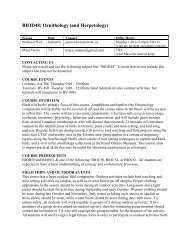
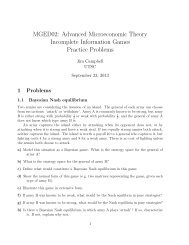


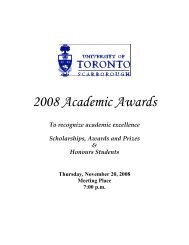
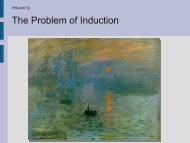
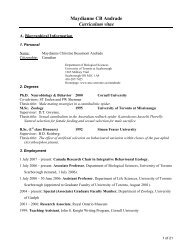
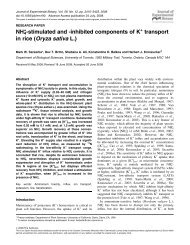
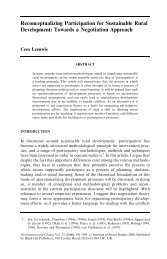

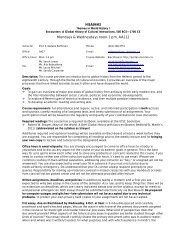
![[Enter course name - Syllabus] - University of Toronto Scarborough](https://img.yumpu.com/50068522/1/190x245/enter-course-name-syllabus-university-of-toronto-scarborough.jpg?quality=85)
